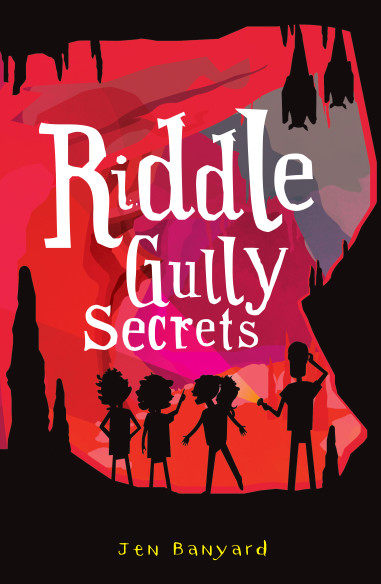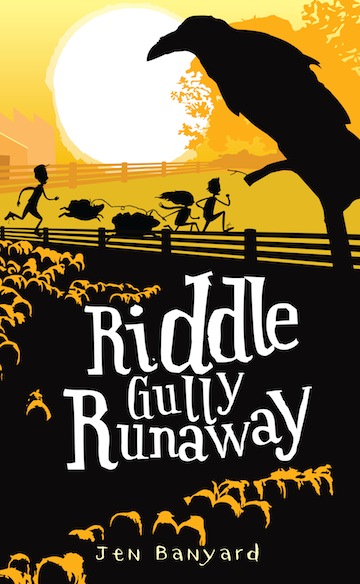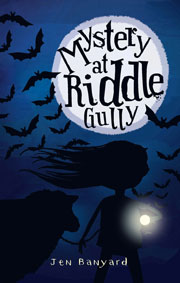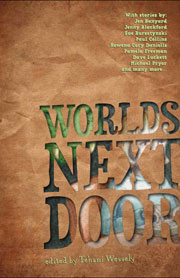Spider Lies – Teaching Notes
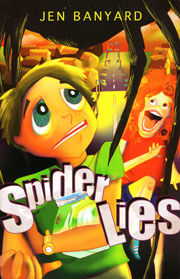
CONTENTS
- Print-friendly PDF download
- Synopsis
- Themes
- Writing style
- Author's springboard
- Author's background
- Study ideas
Print-friendly PDF download
| Download Spider Lies PDF teaching notes |
Synopsis
Spider Lies centres on Connor – a bug-loving ‘Arachnerd’ – and his embarrassing new neighbour, the irrepressible optimist Wart (Winifred Agnes Ravensbridge Tweak). Connor has reared a colony of Moonbeam spiders, now in Space as part of a NASA experiment. However, one of the colony – Alf the Almost Astronaut – was left behind and Connor keeps it in a jar on his desk by the window.
One of the NASA spiders has escaped and been transformed into a giant by the Gargantua Syndrome, a closely guarded secret. It has made its way back to earth and now seeks the solace of its only relative – Alf. It hides in Connor’s elderly neighbour Millie’s mulberry tree by day and camps outside Connor’s window, as near as it can get to Alf, by night. As if it’s not enough that Connor, alone at home for the week, can’t escape the feeling he’s being watched and thinks he’s going around the bend, he has to contend with the embarrassing Wart who insists on being his friend. His social standing will go down the gurgler if he doesn’t shake her off.
Through Herman Hatch, Connor’s brow-beaten mentor at NASA, Connor, Wart and Millie learn the ominous truth – that unless the spider is restored to its original state before it dies (and it’s looking sicker by the day) it may pass on the Gargantua Syndrome to other Moonbeam spiders and set in motion an ecological nightmare. Connor, Wart and Millie must get the spider to the top of Mt Whaleback by midnight, where it can be restored in secret by Herman while his bullying Commander is out of town. The spider is restored – and Millie and her old dog into the bargain – and the two spider siblings are reunited.
The dénouement reveals that Herman’s sinister Commander has been watching all from his private NASA quarters and will use Herman’s unauthorised actions as leverage over him. Herman hangs the consequences and goes off in search of the truth behind the Gargantua Syndrome cover-up. Meanwhile Connor and Wart discover that telling the truth about what happened is going to be harder than they thought.
Themes
Spider Lies is an adventure-comedy that interweaves several themes:
-
Fear of the unknown or misunderstood
Millie accepts the spider at face value, judging it on its actions alone, Wart is afraid of the spider but thinks it might have good intentions and Connor (perhaps understandably) is plain terrified of it. However in the ‘spider-speak’ passages we come to know the spider as a sympathetic creature;
-
Respecting others, looking beyond the surface
Tying in with the previous theme, the ageing Millie illustrates that often those on the sidelines warrant greater appreciation and respect than they receive. For Millie, being ‘not quite what [she] should be upstairs these days’ is only one small element of her rich life;
-
Peer pressure and conforming to the perceived norm
As in Connor’s reluctant friendship with Wart and in Wart’s standing up to the school toughies;
-
Family bonds
The spider will do anything to be with its family, while in contrast Connor was keen to get rid of his;
-
Environmental consequences
The Gargantua Syndrome has the capacity to set off a disastrous chain of ecological events, possibly with the compliance of authorities;
-
The nature of truth
There can be more than one version and more than one way of telling it. Can distortion of the truth ever be okay?
Writing style
Spider Lies is written in an upbeat, humorous tone with dialogue that brings to life the four main characters – Connor, Wart (Winifred Agnes Ravensbridge Tweak), Millie (the old lady next door), and NASA’s Herman Hatch. The action switches between the country town setting of Connor’s home and the dimly lit labyrinth of an imagined NASA headquarters in Houston. To heighten suspense, the author has made extensive use of selective omniscient narration, using the brain and eyes of only one given character to relate a scene.
Author's springboard
The germ for the story came from the author rummaging through her ‘ideas’ box and putting together two newspaper clippings – one on a NASA experiment in which Australian schoolchildren had sent a Golden Orb spider into space, and another describing research whereby spider genes were bred into goats to produce ‘spider web milk’, as in the book. The idea of something going horribly wrong with such experiments followed naturally. The Moonbeam spiders of the story are based on the colony-building Foliage Webbing spider species.
Author's background
Jen Banyard has a background in journalism and has written articles and edited publications in the non-fiction area. In the field of children’s literature, her stories have appeared in the NSW School Magazine and in the anthology ‘Worlds Next Door’. Jen is currently doing a PhD in creative writing at the University of Western Australia. Her second novel, ‘Mystery at Riddle Gully’, will be released by Fremantle Press in 2012.
Study ideas
- In the story the spider looks scary but means no harm.
What are some other instances of this in life, nature, politics?
What would have happened if Connor, Wart and Millie had reacted instantly with violence to the spider? - What makes Wart embarrassing for Connor?
What would you do in Connor’s situation? - What makes families special?
Do you have any family members you don’t get along with (like Connor and his sister)?
How would you feel if that person were in some kind of danger?
How do you deal with conflicts? - Do you know anyone similar to old Millie?
What did that person do? How did they live when they were your age?
Can you picture yourself as an elderly person?
What would change and what would stay the same? - Butt Scuttle comes to grief because of a dare from his little sister.
Have you ever been dared to do something you didn’t want to do?
How did you respond? - There are several lies and cover-ups in the story.
What can be the consequences of telling lies?
Is omitting to mention something, or covering it up, the same as lying?
Is it ever justifiable to tell a lie? (Think outside personal experience to governments etc.) - What do the ‘spider-speak’ passages on pages 88, 124 and 152 mean?
How has the author combined or altered words to convey the idea of a spider thinking?
Try this with other animals by first identifying their key features and preoccupations. Experiment with different points of view of the same event e.g. a dog and a cat when visitors come; an animal being hunted by another animal. - Much of the book is set at night. Discuss setting of the various passages.
How do you feel when you read daytime vs nighttime settings?
How does this affect suspense? - How would the story change if the Commander were a jolly or kind-hearted character?
Would the story be as interesting? - In the story the reader is asked to believe some unbelievable things.
How did the author handle this?
Would further ‘explaining’ have added to or detracted from the story? - Why would a giant spider species destroy the ecosystem?
What are some possible chains of events? - The spider escapes just as the shuttle is about to leave the Earth’s mesosphere and enter the thermosphere and stable orbit. Find out about the different layers of atmosphere and the characteristics of each.
- Find out more about the Foliage Webbing Spider on which the story is based.
Look into the various anatomical and behavioural differences among spiders (eg types and number of eyes, hunting, web-spinning, sociability). - What do you think of the illustrations and cover?
Do they influence the way you read the story?

